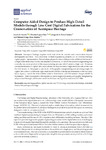Computer Aided Design to Produce High-Detail Models through Low Cost Digital Fabrication for the Conservation of Aerospace Heritage

Use este enlace para citar
http://hdl.handle.net/2183/34608Colecciones
- Investigacion (ETSAC) [494]
Metadatos
Mostrar el registro completo del ítemTítulo
Computer Aided Design to Produce High-Detail Models through Low Cost Digital Fabrication for the Conservation of Aerospace HeritageAutor(es)
Fecha
2019-06-06Cita bibliográfica
Saorín J.L., López-Chao, V., De La Torre-Cantero, J., and Díaz-Alemán, M.D. Computer Aided Design to produce High-Detail Models through low cost digital fabrication for the conservation of aerospace heritage. (2019). Applied Sciences 9(11), 2338. https://doi.org/10.3390/app9112338
Resumen
[Abstract]
Aerospace heritage requires tools that allow its transfer and conservation beyond photographs and texts. The complexity of these engineering projects can be collected through digital graphic representation. Nevertheless, physical scale models provide additional information of high value when they involve full detailed information, for which the model in engineering was normally one more product of the manufacturing process, which entails a high cost. However, the standardization of digital fabrication allows the manufacture of high-detail models at low cost. For this reason, in this paper a case study of the graphic reengineering and planning stages for digital fabrication of a full-scale high-detail model (HDM) of the spatial instrument of the European Space Agency, named the Solar Orbiter mission Polarimetric and Helioseismic Imager (SO/PHI), is presented. After the analysis of this experience, seven stages of planning and graphic reengineering are proposed through collaborative work for the low cost digital manufacture of HDMs.
Palabras clave
Engineering graphics
Digital manufacture
3D printing
Computer-aided design
Autodesk Fusion 360
Aerospace heritage
Digital manufacture
3D printing
Computer-aided design
Autodesk Fusion 360
Aerospace heritage
Descripción
This article belongs to the Special Issue Applied Sciences to the Study of Technical Historical Heritage and/or Industrial Heritage
Versión del editor
Derechos
Atribución 3.0 España
ISSN
2076-3417






